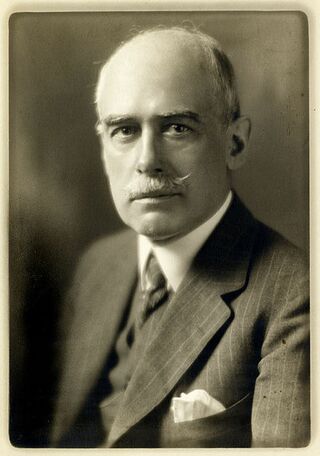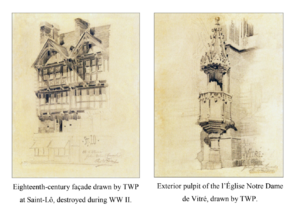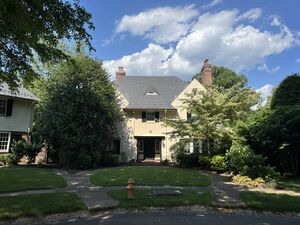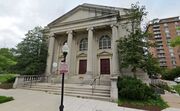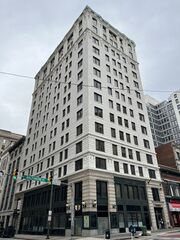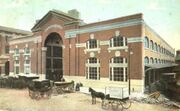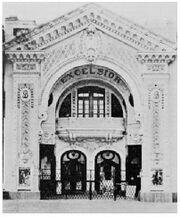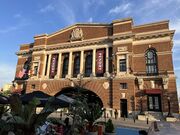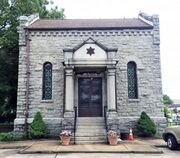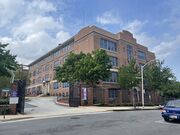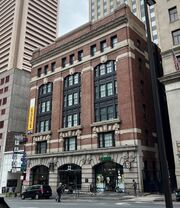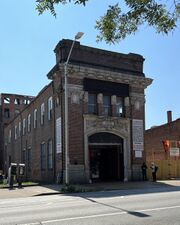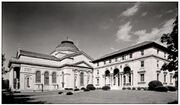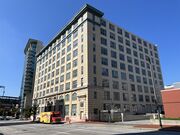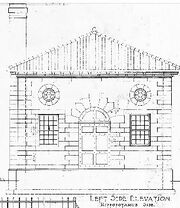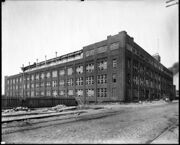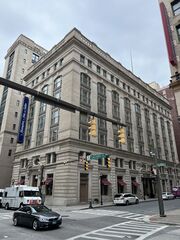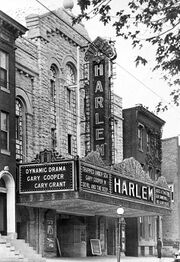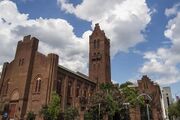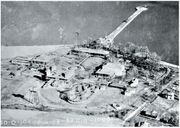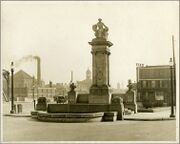Theodore Wells Pietsch
Biography
Many of Theodore Wells Pietsch’s buildings are extant today: Baltimore American Building (1905), Eastern Female High School (1907), renovations to Zion Lutheran Church (1912), Fell’s Point Commercial Wharf and Recreation Pier (1914) [now the Sagamore Pendry Hotel (2017)], The Baltimore Zoo - Elephant House (1926), and Saints Philip & James Catholic Church(1930).
Education
Pietsch was born in Chicago, Illinois, on October 2, 1868. After studying at MIT from 1885 to 1888, he returned to Chicago and worked in the architectural offices of Flanders & Zimmerman and Burnham & Root, positions marking a turning point in his career. He reflected in a letter from 1915, “My architectural short-comings oppressed me keenly, and I soon reached the conclusion that Paris and the École des Beaux Arts were the only remedies for my defects.” Pietsch studied at the École from 1891 to 1898, becoming a student of Marcel-Noël Lambert, chief architect of the Versailles estate.
Apprenticeship
After a brief stint in Chicago, he moved to New York and worked for the architectural firm Howard, Cauldwell, & Morgan. John Galen Howard had also been a student of architecture at MIT, and like Pietsch, Howard left without earning a degree and went on to study at the École. The two were apparently good friends while in Paris together, as evidenced by two architectural drawings made by Pietsch at Vitré and Saint-Lô, which he dedicated to Howard. The eighteenth-century façade at Saint-Lô was destroyed during World War II, but the exterior pulpit at Vitré is extant today. This kind of primary source, contouring a friendship between architects, is rare and valuable in trying to understand Pietsch’s character both within and beyond his profession. When the firm Howard, Cauldwell, & Morgan dissolved in 1901, Pietsch went to work for the firm Hownblower & Marshall in Washington, DC.
While working there, Pietsch assisted in designing the United States Custom House in Baltimore, which was his first project in the city. While in Washington, DC, Pietsch was appointed to the Office of the Supervising Architect of the United States Treasury Department, and he became an active member of the Washington Architectural Club, which attracted young members of the profession, whereas the American Institute of Architects tended to be composed of established ones. Out of this involvement, Pietsch founded the Washington Atelier in 1902, offering scholarships, competitions, meetings, and exhibitions.
Career
Pietsch came to Baltimore just after the Great Baltimore Fire of 1904 and established a partnership with Otto G. Simonson, an architect Pietsch met while working for the United States Treasury Department in Washington, DC. This move and partnership marked the beginning of Pietsch’s career in Baltimore, and he went on to dedicate the rest of his life to designing buildings that would not just restore the decimated city to its former glory, but bring it into a century full of new ideas, challenges, and opportunities. By April 1905, Simonson & Pietsch had their own office in the new Baltimore American Building, the first office building to be constructed after the fire, which they themselves had designed.
Together, Simonson & Pietsch were enormously successful. In January 1905, a journalist from the Baltimore Sun wrote, “Mr. Pietsch is a graduate of the Boston Technology [MIT] and the École des Beaux Arts of Paris, and is the artist of the firm, while Mr. Simonson is the constructor. These gentlemen combine modern art and construction and their varied experience in the designing, supervising and erection of buildings is not surpassed by any other firm.”
Their success was being touted in newspapers and evidenced in their designs going up around the city—Sonneborn Building (1905); Gunther Building (1905); Lanahan Building (1906); Eastern Female High School (1906); US Fidelity & Guaranty Company Building (1906); the Center Market Space (1907); Northern Substation of the United Railways & Electric Company (c. 1906); Mount Royal Garage (1906); River View Amusement Park entrance, music pavilion, and lake (1906); Bay Shore Amusement Park (1906); Horn & Horn Building (c. 1908); N Paca Street Fire-Engine House (Truck House No. 1) (1908). But despite a high level of success, the partnership was said to have been plagued by disagreements and was finally dissolved by February 1908.
On his own, Pietsch had no shortage of work, and work of many kinds. He drew up plans for additions to the Baltimore City Jail, the clubhouse for the Maryland Motor Boat Club, the Abraham Lincoln Public School, the new entrance and chapel for the Hebrew Friendship Cemetery, a branch of the Enoch Pratt Library, a number of private residences, a new Free Public Bath, and new moving-picture theaters, including the Wilson Theater, Elektra Theater, and Excelsior Theater, the latter of which opened in July 1911.
By 1911, Pietsch was also making strides in his personal life. On November 7, 1911, he married Gertrude Carroll Zell, a well-to-do Baltimorean who was said to have been the first woman to drive a car in Maryland. She was the niece of Maryland’s foremost Packard dealer. Her uncle, Arthur Stanley Zell, owned the Mount Royal Garage a building that had been designed by Pietsch and opened in October 1905. Pietsch and Zell had three children and lived at 4327 Wickford Road in Roland Park.
Around 1925, Pietsch began working on what is generally considered his masterpiece, Saints Philip & James Catholic Church at the corner of Charles and 29th Streets. The old building needed to be replaced for baptisms, confirmations, and other large events. The pews kept overflowing, forcing parishioners to stand in the aisles and at the rear. Upsizing was necessary, but Father Wade’s choice was somewhat unusual. Pietsch was not a native Baltimorean, nor was he Catholic. But he got to work anyway. A number of local contractors placed bids. The contract went for $388,918 to the M.A. Long Construction Company. Pietsch was a design perfectionist, and he wanted his composition to possess both dignity and grace, matching the opportunity that the site afforded him.
Death
Before construction of Saints Philip & James Catholic Church was complete, Pietsch died on January 1, 1930 from a self-inflicted gunshot wound in the studio above his garage. He’d stayed home while his wife and three sons went to church. Late on New Year’s Day, Baltimoreans were stunned to see the headline of the Evening Sun, reporting the tragic news. The Sun eulogized: “His enthusiasm, his individuality and his earnestness are remembered. He had ideals that neither a call for haste nor a demand for cheapness could subdue.”
What people wanted to know was why a man at the height of his career, with a beautiful home and family, would take his own life. It’s a mystery that invites speculations to this day, none of which are conclusive. Some say he took his own life, as many did around this time, on account of the doomed economy during the Great Depression. Some say he suffered from a form of depression that was slated for treatment the following week. Perhaps most thoroughly evidenced in the primary sources of his life, although fraught with ahistorical projection, some say Gertrude was lesbian and her long-term affairs with other women were the crux of his desperate act. Speculations fan the embers of scandal, but they place blame unfairly and raise more questions than they answer. Either way, it was a heartbreaking end to the life of one of Baltimore's most enduring and intriguing architects.
By Dom Guida, based on research done by Theodore Wells Pietsch III
Projects
Map
| Library |
Church |
Government |
Commercial |
Dwelling |
Park |
Educational |
|---|
Listing
